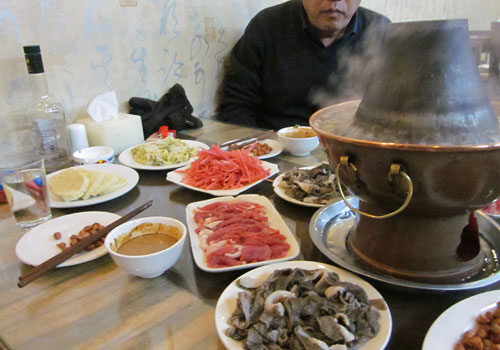| Where tripe is prime | |
http://english.dbw.cn
2011-04-02 13:51:05
|
|
|

The Jinshenglong Restaurant specializes in tripe, but Hui-style hotpot is also popular. [Photo:CRIENGLISH.com]
The Jingshenglong Restaurant near Gulou Dajie, operated by the same family for four generations, specializes in tripe and traditional Hui fare. The restaurant's history dates back to 1894, when Feng Tianjie came to Beijing to escape the famine in his home province of Shandong. Too poor to open a restaurant, Feng Tianjie made a living by selling tripe from a street stand outside Donganmen. His first guests were the attendants who were waiting for their wealthy Chinese bosses who were visiting the imperial court. Later, wealthier guests caught on to the trend as well, nicknaming his stand "Baodu Feng."
In 1903, the nearby Dongan Martket opened, and Feng Tianjie was able to open a proper restaurant. By then, Feng Tianjie's second son, Feng Jinsheng, was operating the restaurant, and he gave the establishment a more elegant name -- "Jinshenglong." To cater to increasingly wealthy clients, the Jinshenglong Restaurant developed its tripe offerings, dividing the tripe into different parts according to texture and flavor and seeking only the best ingredients. Actors from the theatre in the north corner of the market also patronized the restaurant because, unlike other restaurants on the street, Jinshenglong remained open after they finished performances. These actors demanded more than just tripe, so other Hui dishes, such as roasted mutton, were added to the menu. After the establishment of the People's Republic of China, the Jinshenglong was consolidated with seven other restaurants into a state-owned chain under the same name. Feng Jinsheng considered the name a success. "My grandpa regarded it as his biggest pride," said current owner Feng Mengtao. "He was no longer a merchant, but a member in a state-owned restaurant." |
|
| Author: Angela Pruszenski Source: CRI Editor: Wu Qiong |
|
 中文简体
中文简体










